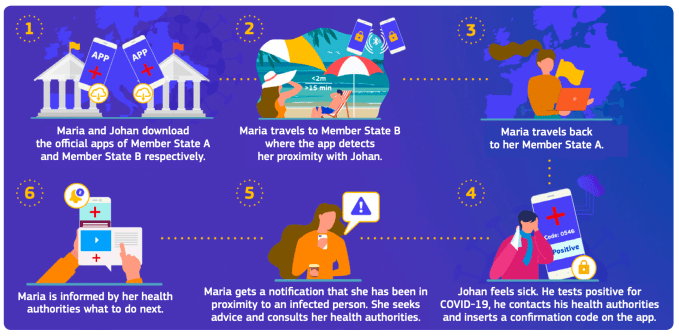The European Union has switched on cross-border interoperability for a first batch of COVID-19 contacts tracing apps that use Bluetooth proximity to calculate the exposure risk of smartphone users after a pilot of the system last month.
National apps whose backends are now linked through the gateway service are Germany’s Corona-Warn-App, the Republic of Ireland’s COVID tracker, and Italy’s immuni app.
This means a user of one of those apps who travels to any of the other countries can expect their national app to send relevant exposure notifications in the same way it should if they had not travelled — without the need to download any additional software.
Collectively, the three national COVID-19 apps have been downloaded by around 30 million people which the EU said corresponds to two-thirds of such downloads in the region.

Image credit: EU Publications Office
Other national apps are expected to gain interoperability as they are added to the service in the coming weeks — with at least 18 more compatible national apps identified at this stage.
A second batch of national apps is expected to be added next week after a period of testing — namely: Czechia’s eRouška, Denmark’s smitte stop, Latvia’s Apturi COVID and Spain’s Radar Covid (although the latter still doesn’t have full coverage in Spain with the Catalonia region yet to integrate it with its regional healthcare system). Further compatible apps are slated to be added in November.
The gateway has been designed to work, in the first instance, with official coronavirus apps that have a decentralized architecture — meaning any that use a centalized architecture, such as France’s StopCovid app, aren’t currently compatible.
The UK’s collection of apps, meanwhile — for England & Wales, Scotland and Northern Ireland — are unlikely to get plugged in, despite having a technically compatible app architecture, as the country is due to exit the trading bloc at the end of this year. (So interoperability would require a separate agreement between the UK and the EU.)
“About two third of EU Member States have developed compatible tracing and warning apps, and the gateway is open to all of them, once they are ready to connect. The connection will gradually take place during October and November, however apps can also connect at a later stage if national authorities wish so. An ‘onboarding protocol’ has been developed, setting out the necessary steps,” the Commission notes in an Q&A.
The cross-border system for the EU’s apps works via the use of a gateway server, developed and set up by T-Systems and SAP and operated from the Commission’s data centre in Luxembourg, which receives and passes on arbitrary identifiers between national apps.
“No other information than arbitrary keys, generated by the apps, will be handled by the gateway,” the EU notes in a press release. “The information is pseudonymised, encrypted, kept to the minimium, and only stored as long as necessary to trace back infections. It does not allow the identification of individual persons, nor to track location or movement of devices.”
Getting a cross-border system up and running so swiftly across a patchwork of national COVID-19 apps is an achievement for the EU, even as there are ongoing questions about the utility of Bluetooth-based coronavirus exposure notifications in the fight against the spread of the novel coronavirus — with much of Europe now experiencing a second wave of the pandemic.
However EU commissioners suggested today that such apps can be a useful complement to other measures, such as manual contact tracing.
Commenting in a statement, StellaKyriakides, EU commissioner for health and food safety, said: “Coronavirus tracing and warning apps can effectively complement other measures like increased testing and manual contact tracing. With cases on the rise again, they can play an important role to help us break the transmission chains. When working across borders these apps are even more powerful tools. Our gateway system going live today is an important step in our work, and I would call on citizens to make use of such apps, to help protecting each other.”
“Free movement is an integral part of the Single Market — the gateway is facilitating this while helping save lives,” added Thierry Breton, commissioner for the internal market.
https://ift.tt/37kag0r
No comments:
Post a Comment